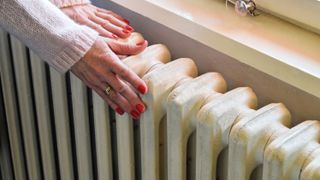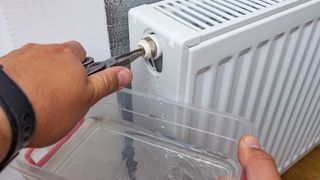How to bleed a radiator to remove air
Here's how to bleed a radiator and get the most out of your heating this winter

Knowing how to bleed a radiator will make all the difference to your heating this winter. If you’re turning up your heating, but find one or more of your radiators is stone cold, it's most likely that they need bleeding. You can bleed a radiator by essentially letting out trapped air that prevents water from heating up the entire radiator.
Another sign that your radiators need bleeding is if they make rattling, banging or gurgling noises, which can be a common issue for many households. Similar to insulating your windows for winter, knowing how to bleed a radiator will save you money on energy bills, as you won't be losing heat.
Luckily, bleeding a radiator is quick, easy and won't cost a thing. Follow these simple steps on how to bleed a radiator and keep your home toasty this winter.
- Here's how to clean a glass shower door
- Cut down your bills with these 11 essential tips for saving on your energy bill
Before you start, it’s advisable to identify which radiators need bleeding.
How to bleed a radiator to remove air
A radiator bleeding key
Small container or towel to catch any drips of water
Cloth
Safety gloves
1. Check and diagnose your radiators — First, you'll need to turn your heating on in full so it reaches its highest temperature. Run your hand along the top of each radiator to see if there are any cold spots. If you find radiators that have cold areas, those are the ones that need to be bled.

2. Next up, turn off your radiators and allow to fully cool down. This is to prevent the risk of getting scolded from the hot water inside the radiators.
3. Once you’ve identified which radiators need bleeding, locate the radiator bleed valve which is usually at the top end. It tends to be a small metal screw or nut found inside a surrounding nut fixture.
Sign up to get the BEST of Tom’s Guide direct to your inbox.
Upgrade your life with a daily dose of the biggest tech news, lifestyle hacks and our curated analysis. Be the first to know about cutting-edge gadgets and the hottest deals.

4. To prevent messy spills discoloring your floor, lay down old towels or a tray to catch any water drips.
5. Insert your radiator key into the valve and slowly turn anti-clockwise to the halfway point to release the air pressure. If you've lost your key, you can find a suitable replacement on Amazon, such as the Wal-Rich Radiator Bleeding Air Valve Key.
You should hear a hissing sound as you turn the valve, meaning the trapped air is coming out. It’s advisable to hold a container underneath to catch any residual droplets of water.

6. Once the valve starts to release a steady stream of water, that signals the air is fully released, and you can now close the valve. Simply turn the valve clockwise to tighten it, and you’re all finished! You can repeat these steps for any other radiator around the home that needs bleeding. Turn your heating back on and double check there are no cold areas over the radiator.

Other tips when bleeding a radiator
- How often should I bleed my radiator? — It's recommended that you bleed your radiators at least once a year. Especially before the winter months arrive so you won't feel the chill.
- How long will it take to bleed a radiator? — Typically, it takes around 20-30 seconds to bleed a radiator. But this will depend on the size of your radiator and how much air it has inside.
- What happens if my radiator is still cold after bleeding?— If you're still finding cold patches at the top you may need to bleed again. However, if you're feeling cold spots at the bottom of your radiator, this might indicate a sediment build-up inside the base. In which case, the whole system would need to have a flush-out, and you would need to call in a professional to do this.
Apart from bleeding you're radiators there are a few other ways to get the most out of your radiators.

As the Homes Content Editor, Cynthia Lawrence covers all things homes, interior decorating, and garden-related. She has a wealth of editorial experience testing the latest, ‘must-have’ home appliances, writing buying guides and the handy ‘how to’ features.
Her work has been published in various titles including, T3, Top Ten Reviews, Ideal Home, Real Homes, Livingetc. and House Beautiful, amongst many.
With a rather unhealthy obsession for all things homes and interiors, she also has an interior design blog for style inspiration and savvy storage solutions (get rid of that clutter!). When she’s not testing cool products, she’ll be searching online for more decor ideas to spruce up her family home or looking for a great bargain!
